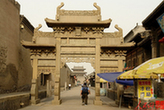a. Brief Introduction
Situated on Potala Mountain in Lhasa, capital of the Tibet Autonomous Region, the Potala Palace was first built in the 7th century, for the wedding of the Tibetan king Songtsan Gompo and Princess Wencheng of the Tang Empire. Since it was completed, the palace has been expanded many times. In 1645, the 5th Dalai Lama was appointed by the government of the Qing Dynasty as the local temporal and religious leader of Tibet, and the palace was reconstructed. In 1653, the 5th Dalai Lama moved from Drepung Monastery to the palace. Thus the Potala Palace became the political center of Tibet.
The Potala Palace's halls include worship and pagoda halls, the North Square, the South Square and the Dragon King Pond. The Main Building has 13 floors, with a height of some 110 m and a width of about 360 m. It is surrounded by eight temples, where there are tens of thousands of Buddhist statues. In the Buddhist Practice Cave are preserved the paintings of Songtsan Gompo and Wencheng made in the 7th century. Pagodas in the pagoda halls for each Dalai Lama are well built, in particular, the pagoda for the 5th Dalai Lama, which has a gold covering and is decorated with valuable jewels. Another important building is Qingsha, where the ministers for Tibetan affairs of the Qing Dynasty presided over the inauguration of the Dalai Lamas.
b. Cultural Heritage
Built on a mountain slope over 4000 m above sea level, the Potala Palace is known as the Pearl on the Roof of the World. Its construction and furnishing reflect the superb skills of ancient artisans and the great attainments of Tibetan architecture.
Superb Architectural Achievements
The Potala Palace is composed of the Red Palace, the White Palace and some other accompanying buildings. These buildings were constructed at different times, but they are all in harmony with the surrounding terrain, so that the whole building complex appears magnificent and integrated. It is a real ingenious masterpiece.
A Paradigm of Perfect Integration of Buddhist Temples with Palace Buildings





Why not rent a boyfriend, or girlfriend to please parents during the Spring Festival?